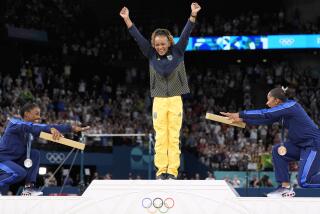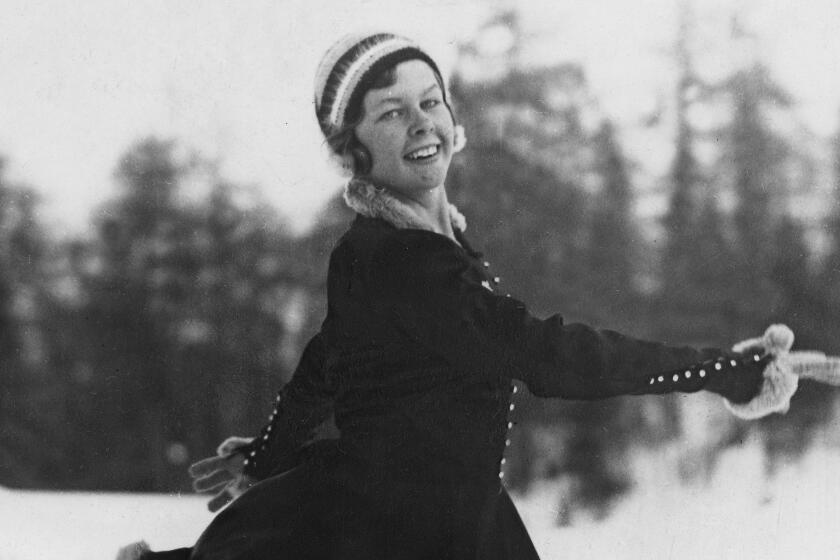It’s a Battle of Generations
ST. LOUIS — In with the old, out with the new.
Or out with the new, in with the old.
For the record:
12:00 a.m. Aug. 31, 2000 For the Record
Los Angeles Times Thursday August 31, 2000 Home Edition Sports Part D Page 7 Sports Desk 1 inches; 29 words Type of Material: Correction
Gymnastics--A July 27 column on the development of the women’s Olympic gymnastic team referred to men competing on the uneven parallel bars. Only women compete on the uneven bars; men compete on parallel bars.
Or a bit of both.
As the U.S. John Hancock Gymnastics Championships begin, there are five women from the 1996 U.S. gold-medal winning team trying to earn a spot in the 2000 Olympics.
They were called the “Magnificent Seven,” on their post-Atlanta tour. As the first U.S. women’s team to win gold, the seven competitors performed an exhibition tour around the country then went off to college, to marriage, to life.
Of the 1996 Olympians, only Amy Chow, a 22-year-old Stanford student, continued competing until this past year.
At these championships, from which the top 12 women and 14 men advance to the Olympic trials next month in Boston, 1996 Olympians Shannon Miller, Jaycie Phelps, Dominique Moceanu and Dominique Dawes are here and not at all feeling guilty about trying to knock off the new generation.
Of all the returnees, Miller, 23, is the biggest surprise.
She is married now, and a student at Oklahoma. As the U.S. gymnast with the most Olympic medals in history (two gold, two silver and three bronze), no one expected Miller back. But six months ago she felt the urge to return.
Her coach, Steve Nunno, was skeptical. Nunno worked Miller out in a devilishly hard way, expecting Miller would quit. But Miller didn’t. “I think I proved I really want to do this,” Miller said. “I really missed competing and I think I still have something to contribute.”
Dawes, 23, Phelps, 20, and Moceanu, 18, felt the same way. Dawes was attending Maryland and pursuing a modeling and acting career. Phelps has attended Arizona State while training. Moceanu had a public break with her father, which included a restraining order to keep her father away and a dispute about what happened to the money Moceanu had earned on the post-Olympic tour.
Challenging these veterans are two-time U.S. national all-around champion Kristen Maloney, 19; Elise Ray, 18, the highest-ranked U.S. gymnast at the 1999 World Championships; Vanessa Atler, 18, of Canyon Country, the vault champion and all-around runner-up at the 1999 U.S. Championships; plus 1999 U.S. World Championship team members Alyssa Beckerman; Jeanette Antolin, from Huntington Beach; Jamie Dantzscher, from San Dimas; and Morgan White.
Bela Karolyi, who was brought in to rescue the U.S. women after they had finished a disappointing sixth at last year’s world championship, has watched members of the 1996 team return and rubbed his head.
“Now you see why I have such a headache,” Karolyi says. “It’s nice to see the veterans back, but you have to prove your capabilities on the floor. I wish they had started a little earlier.”
Miller says that might have been nice, but, asks, “Would our bodies have held up? I know how to go into a competition when I’m trained and ready to go. I know how to handle the pressure.”
In fact, Miller suffered a stress fracture in her left leg a month ago. Nunno said Miller will not compete in the all-around competition here and will, instead, try to enter a couple of the event finals.
Though the rules say an athlete must compete in the all-around before making the event finals, Nunno hopes to get Miller a dispensation.
“We don’t want to push Shannon to the point where we injure something else,” Nunno said. He watched Maurice Greene and Michael Johnson push themselves into injuries at last weekend’s U.S. track and field trials, and Nunno doesn’t want that to happen to Miller.
And there is a loophole in that rule where only the top 12 women and 14 men move on to the Olympic trials. An injured athlete can petition for a spot in Boston. Miller, with her credentials, won’t have a problem with that.
Since 1996, gymnastics has changed. There is a new scoring system and age restrictions that don’t allow anyone younger than 16 to compete at Olympic and World Championships. The start values--the score from which judges begin deducting points--have changed so that gymnasts have had to learn more difficult routines to score well.
Karolyi also will have more power in choosing the women’s Olympic team than any coach in the past. The top three scorers after the Boston trials (40% of the final score will be from this meet, 60% from the Boston trials) are automatically named to the Olympic team. Karolyi and a committee of three others can choose anyone they want for the other three spots.
The idea is that Karolyi, who has been training the top 20 gymnasts in the country at his Houston ranch for a week every month since January, can use his discretion in picking athletes he feels can best help the team.
The men began competing Wednesday night. Medals were awarded in all the event finals.
Blaine Wilson, 25, who is trying for a record fifth consecutive national all-around title, won three event gold medals and two bronze. He is also in first place in the all-around after the preliminaries. Wilson was first on the floor exercise, rings and vault and third on the pommel horse and uneven bars.
John Roethlisberger, 31, seeking his third Olympic team berth, was second to Wilson until his last rotation, the floor exercise. Roethlisberger had a bad fall on his dismount, scored a 7.90 and dropped to sixth place overall. Roethlisberger did win a gold medal on the pommel horse, a silver medal on rings and a bronze on the vault.
The other event gold medalist was Trent Wells of Berkeley, who won the uneven bars and high bar.
(BEGIN TEXT OF INFOBOX / INFOGRAPHIC)
U.S. Gymnastics Championships
This is the first of two qualifying events for men and women to determine the 2000 Olympic team. The U.S. Olympic trials (Aug. 17-20) in Boston is the other.
* When: Wednesday-Saturday.
* Where: St. Louis.
* What it means: The top 12 women and top 14 men here advance to the trials. The selection process will combine overall scores from St. Louis (40%) and Boston (60%) to automatically give Olympic berths to the top three women and top four men. Committees will select the remaining three women and two men.
More to Read
Go beyond the scoreboard
Get the latest on L.A.'s teams in the daily Sports Report newsletter.
You may occasionally receive promotional content from the Los Angeles Times.







